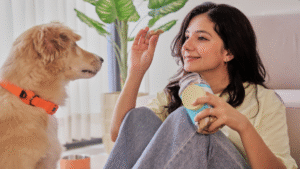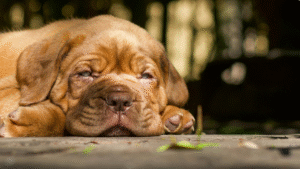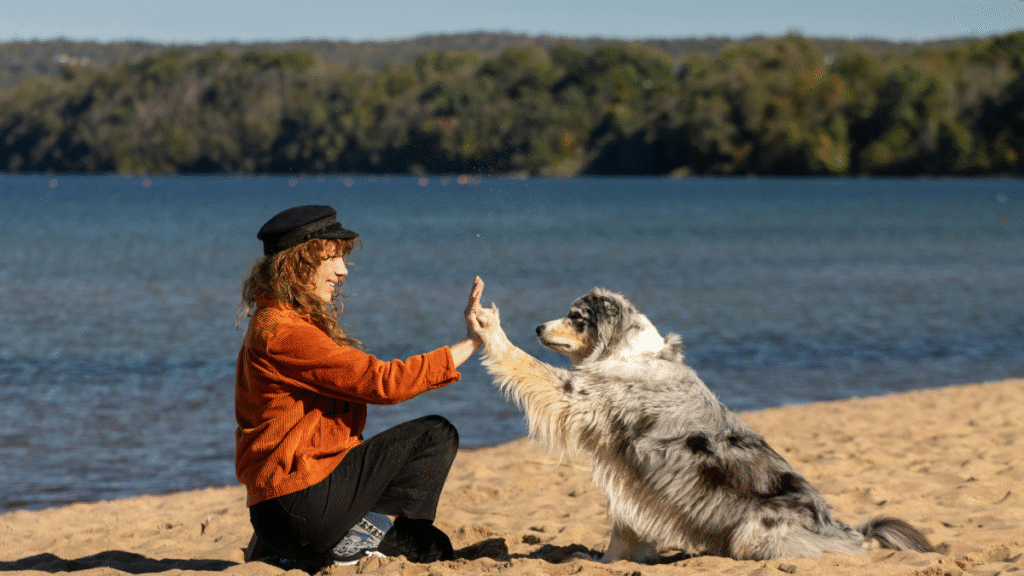Training your dog to perform new tricks is one of the most enjoyable parts of being a pet parent. One of the funniest and easiest tricks you can teach is the high-five. Seeing your dog give you a perfect high-five is just about as cute as it gets!
Although some people think it takes weeks of training to teach dogs tricks like this, with the proper technique, patience, and positive reinforcement, you can teach your dog to high-five in just a matter of minutes.

Why Teach Your Dog to High-Five?
Training your dog new tricks has benefits that go far beyond entertainment. Trick training builds trust, strengthens obedience, and provides excellent mental stimulation for your dog.
Here are a few reasons why learning how to teach your dog to high-five is worth it:
Strengthens your bond:
Teaching your dog new tricks means spending quality time together, learning to read each other’s cues, and improving communication. Positive training sessions deepen the trust and affection between you and your pet.
Provides mental stimulation:
Dogs are intelligent, curious animals who love to learn. Trick training is a great way to provide mental enrichment and prevent boredom — especially for smart breeds like Border Collies, Poodles, and German Shepherds.
Builds confidence:
Mastering new behaviors can be challenging, so every trick your dog learns is a confidence booster — especially for shy or anxious dogs.
Impresses your friends:
Let’s be honest — a dog high-fiving never fails to make people smile.
What You’ll Need to Get Started
To teach your dog to high-five quickly and easily, you’ll need a few simple things on hand:
Treats:
Use small, tasty treats your dog loves. Soft treats work best because they’re easy to chew and won’t interrupt the flow of training.
Clicker (optional):
If you use clicker training, keep it handy to mark desired behaviors. Otherwise, use a verbal marker like “Yes!” or “Good!”
A quiet space:
Choose a calm, distraction-free environment where your dog can focus.
Patience and enthusiasm:
Keep training sessions short (5–10 minutes) and positive, always ending on a success. Stay patient and upbeat throughout the process.

Step-by-Step Guide
Step 1: Start with the “Shake” or “Paw” Command (If Your Dog Knows It)
If your dog already knows how to “shake” or “give paw,” you’re halfway there. The high-five trick is simply an extension of that behavior.
Ask for a “paw,” but instead of taking it in your hand, raise your hand higher in the air as if you’re asking for a high-five. Reward your dog immediately when their paw touches your hand, and repeat several times. As your dog catches on, they’ll start offering this behavior naturally.
If your dog doesn’t already know how to “shake,” don’t worry — you can start from scratch.
Step 2: Get Your Dog to Touch Your Hand
Sit in front of your dog and present your open palm, holding a treat in your other hand to show that a reward is coming. Most dogs will sniff, lick, or paw at your open hand out of curiosity.
The instant your dog’s paw touches your hand — even by accident — mark the behavior with a click or a verbal cue like “Yes!” and immediately reward with a treat.
Repeat several times until your dog begins to understand that touching your hand with their paw earns a reward.
Tip:
If your dog isn’t using their paw, try rubbing a bit of treat scent on your hand to attract their attention. Some dogs need a little extra encouragement to use their paw instead of their nose.

Step 3: Add the Verbal Cue “High-Five”
Once your dog reliably touches your hand with their paw, it’s time to add the verbal cue.
Before presenting your hand, say “High-five!” clearly, then hold up your open palm. When your dog paws your hand, reward them immediately. After a few repetitions, your dog will start associating the word “high-five” with the action.
Repeat this in short sessions. You’ll know your dog understands the command when they lift their paw as soon as they hear “high-five,” even before you raise your hand.
Step 4: Increase the Height Gradually
To make it look more like a real high-five, gradually raise your hand higher as your dog becomes more comfortable. Start low, then lift your hand a bit higher each time, encouraging your dog to reach up farther with their paw.
Always reward successful attempts — even if they only brush your fingers at first. With repetition, your dog will learn to lift their paw confidently and make solid contact.
Step 5: Practice, Praise, and Keep It Fun
Practice makes perfect, but keep training short and enjoyable. Many dogs can learn the high-five in just a few minutes, but others may take a few sessions.
If your dog seems tired, distracted, or bored, take a break and try again later. Always end training on a success, even a small one. A happy, confident dog learns faster.
Use enthusiastic praise and upbeat body language when your dog performs correctly — dogs love making you happy!
Troubleshooting Common Problems
Even simple tricks can present challenges. Here’s how to handle the most common ones:
Problem 1: My dog won’t lift their paw.
Try “shaping” the behavior by rewarding small movements in the right direction. If your dog shifts their weight or lifts a paw slightly, mark and reward it. Gradually wait for higher lifts before rewarding again.
Problem 2: My dog keeps using their nose.
Move your hand slightly higher or farther from their face. This often encourages them to reach with their paw instead of their nose.
Problem 3: My dog gets frustrated or walks away.
Keep sessions short — no more than five minutes. Always end on a positive note and ensure training feels like playtime, not work.
Problem 4: My dog high-fives too hard.
If your dog gets too excited and slams their paw down, tone down your praise slightly and introduce a “gentle” cue to help them moderate their enthusiasm.

Building on the High-Five Trick
Once your dog has mastered the high-five, you can use it as a foundation for more advanced and entertaining variations.
Here are some ideas:
Double High-Five:
Hold out both hands and encourage your dog to lift both paws for a double high-five. This one always gets a big reaction.
Wave:
After mastering high-five, teach your dog to lift their paw and “wave” without actually touching your hand.
High-Ten:
A fun version where your dog jumps up to touch both your hands simultaneously — perfect for energetic dogs.
Combining these tricks into a short routine keeps your dog mentally engaged and turns simple gestures into an impressive performance.
Training Tips for Success
To make training sessions enjoyable and effective, keep these professional tips in mind:
-
Use positive reinforcement: Reward desired behaviors with treats, toys, or praise. Never punish or scold your dog for mistakes — it only creates fear and confusion.
-
Keep sessions short and frequent: Multiple five-to-ten-minute sessions each day are more effective than one long session.
-
Be patient: Some dogs are quick learners; others need more time. Patience is key to success.
-
Train when your dog is calm and alert: Avoid training when your dog is overly tired, distracted, or hungry.
-
Use consistent cues: Always use the same command and hand signal to prevent confusion.
-
End on a positive note: Finish every session with a success, no matter how small, to keep your dog motivated.
Why Positive Reinforcement Works Best
Positive reinforcement is the most effective way to train your dog. It rewards good behavior instead of punishing mistakes, helping your dog understand what earns rewards and encouraging them to repeat those actions.
Using praise, affection, and small treats not only speeds up learning but also builds trust and strengthens your bond. Dogs learn best when training feels like play — not pressure.
Final Thoughts
Teaching your dog to high-five isn’t just a fun party trick — it’s an exercise in communication, trust, and teamwork. With a few short, enjoyable training sessions, your dog will soon be confidently giving high-fives and showing off to everyone.
- 5 Cheap Alternatives To Dog Training Equipment - November 12, 2025
- Homemade Calming Spray To Help Dogs During Training - November 12, 2025
- 7 DIY Dog Training Tools You Can Make From Household Items - November 12, 2025
